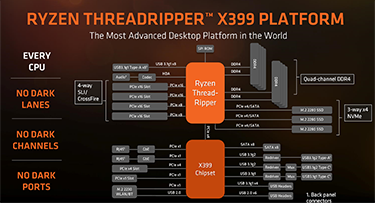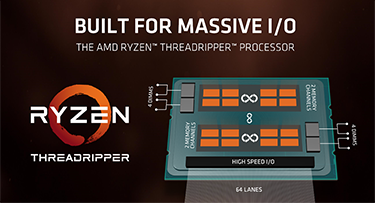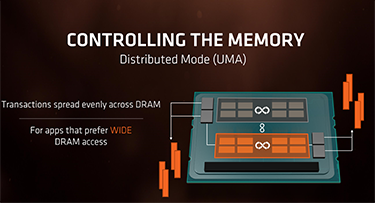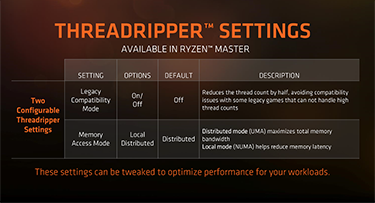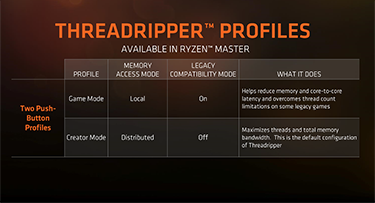The X399 Chipset, Mode Mania
Threadripper's unique multi-die design is presented in a giant TR4 package serviced by a new X399 chipset described by AMD as "the most advanced desktop platform in the world."
Ryzen Chipsets: X399 vs. X370 |
|||||||
|---|---|---|---|---|---|---|---|
| Chipset | Socket |
USB 3.1 Gen 2 |
USB 2 + 3 |
SATA |
CrossFire / Sli |
Memory Channels |
PCI e Lanes |
| X399 | TR4 |
Native |
20 |
12 |
3 x16 + 1 x8 2 x16 + 3 x8 1 x16 + 5 x8 |
Quad DDR4 |
60 G3 8 G2 |
| X370 | AM4 |
Native |
16 |
10 |
1 x16 2 x8 |
Dual DDR4 |
20 G3 8 G2 |
The goal, at this end of the market, is to throw-in everything but the kitchen sink and provide massive amounts of I/O. Compared to X370, X399 offers quad-channel memory, more USB, more SATA and, crucially, three times as many PCIe lanes. Remember, all of the aforementioned is available to any current Threadripper CPU, including the $549 1900X.
Such an array of features ensures that X399 won't come cheap - the initial crop of boards range from £350 to £550 - but that's a small price to pay for users who need to be able to use up to seven PCIe devices simultaneously. Our initial experience with X399 boards seems to suggest that AMD has learnt from previous Ryzen missteps, as memory works just fine at a swift 3,200MHz, and installing the CPU is an experience in itself.
AMD bundles a torque wrench as part of the retail CPU packaging, and the Threadripper chip itself sits on an orange sled that slides into position before being secured with three screws. It's unlike any CPU we've worked with, but do be aware that the large size negates compatibility with most existing coolers. A list of compatible thermal solutions is available at amd.com and a bracket is included in the Threadripper box to enable compatibility with a selection of existing Asetek-based all-in-one liquid coolers.
The Pitfalls Of 20+ Threads
Creating the world's first consumer CPUs to feature more than 20 threads is no small feat, and it hasn't been smooth sailing for AMD's engineers. When testing Threadripper parts, the team found that a handful of games would simply refuse to launch on a system with more than 20 threads. Wanting to get ahead of the problem, and avoid any recurrence of the 'Ryzen is bad for gaming' mentality, AMD has added a toggle to the Ryzen Master Utility for 'Legacy Compatibility Mode.'
Available solely for applications that fail to function with over 20 threads, Legacy Compatibility Mode effectively hides one die (two CCXs) from the OS, taking the core/thread count down to 8/16 for the 1950X and 6/12 for the 1920X. We imagine developers will ensure compatibility on all future titles, yet Legacy Compatibility Mode is available as a short-term fix, if needed.
Having too many threads isn't the only Threadripper peculiarity. The chip's multi-die approach is serviced by an Infinity Fabric link offering 102GB/s of bi-directional die-to-die bandwidth, yet memory latency ultimately takes a hit, resulting in AMD providing a choice of distributed or local memory-access modes.
Once again controlled via the Ryzen Master Utility, and requiring a reboot to initiate, switching from the default distributed mode to the optional local mode helps lower latency at the expense of maximum bandwidth by carrying out transactions in die-local memory. Hoping to simplify matters, there are two pre-existing profiles to choose from; Creator Mode, the default; and Game Mode, which switches on Legacy Compatibility Mode and toggles local memory access.
What's confusing, and troublesome for users who just want a CPU to work, is that AMD has tested many games and found that they are sensitive to different variables, including core count, frequency, memory latency and core-to-core latency. There's no one-setting-is-best for gaming, and while some games see a performance uplift of as much as 37 per cent with Game Mode enabled, others that are core or bandwidth sensitive see a sizeable performance drop.
It's a rocky start to the era of mega-tasking, but while it's good to see AMD providing a choice of settings to optimise for particular workloads, software optimisations in the months or years ahead will hopefully cancel out the need for these BIOS-controlled settings.
So we thought how about testing AMD's assertions of Game Mode vs. Creator Mode. We did just this in three games - Deus Ex: Mankind Divided, Hitman, and Total War: Warhammer, benchmarked at our standard premium-quality settings. This is how it turned out.



What we see is a mixed bag of results. The winner here, in Game Mode, is Total War: Warhammer, but remember that going into this mode reduces the core count by half. We'll do more testing as time permits. More importantly, you will see how Threadripper compares against a host of other chips later on in this review.






